

Classical and Quantum fields. Classical field theory. Lagrangian formalism. Single and many-particle Quantum mechanics. Quantum mechanics. Wavefunctions of the electron in a hydrogen atom at different energy levels.
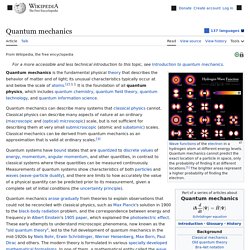
Quantum mechanics cannot predict the exact location of a particle in space, only the probability of finding it at different locations.[1] The brighter areas represent a higher probability of finding the electron. Quantum mechanics (QM; also known as quantum physics, quantum theory, the wave mechanical model, or matrix mechanics), including quantum field theory, is a fundamental theory in physics which describes nature at the smallest scales of atoms and subatomic particles.[2] Quantum mechanics gradually arose from theories to explain observations which could not be reconciled with classical physics, such as Max Planck's solution in 1900 to the black-body radiation problem, and from the correspondence between energy and frequency in Albert Einstein's 1905 paper which explained the photoelectric effect. History[edit] In 1838, Michael Faraday discovered cathode rays. Where h is Planck's constant. Coulomb potential. First quantization. A first quantization of a physical system is a semi-classical treatment of quantum mechanics, in which particles or physical objects are treated using quantum wave functions but the surrounding environment (for example a potential well or a bulk electromagnetic field or gravitational field) is treated classically.
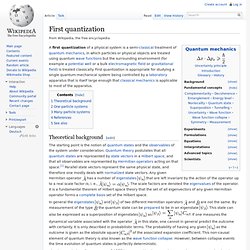
First quantization is appropriate for studying a single quantum-mechanical system being controlled by a laboratory apparatus that is itself large enough that classical mechanics is applicable to most of the apparatus. Theoretical background[edit] The starting point is the notion of quantum states and the observables of the system under consideration. Quantum theory postulates that all quantum states are represented by state vectors in a Hilbert space, and that all observables are represented by Hermitian operators acting on that space.[1] Parallel state vectors represent the same physical state, and therefore one mostly deals with normalized state vectors. . , i. e and . Quantum electrodynamics. In particle physics, quantum electrodynamics (QED) is the relativistic quantum field theory of electrodynamics.
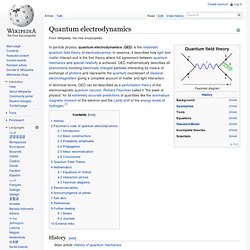
In essence, it describes how light and matter interact and is the first theory where full agreement between quantum mechanics and special relativity is achieved. Quantum hydrodynamics. Quantum hydrodynamics (QHD) is most generally the study of hydrodynamic systems which demonstrate behavior implicit in quantum subsystems (usually quantum tunnelling).
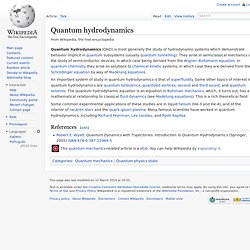
They arise in semiclassical mechanics in the study of semiconductor devices, in which case being derived from the Wigner–Boltzmann equation. In quantum chemistry they arise as solutions to chemical kinetic systems, in which case they are derived from the Schrödinger equation by way of Madelung equations.
An important system of study in quantum hydrodynamics is that of superfluidity. Some other topics of interest in quantum hydrodynamics are quantum turbulence, quantized vortices, second and third sound, and quantum solvents. The quantum hydrodynamic equation is an equation in Bohmian mechanics, which, it turns out, has a mathematical relationship to classical fluid dynamics (see Madelung equations).
Second quantization. Second quantization is a powerful procedure used in quantum field theory for describing the many-particle systems by quantizing the fields using a basis that describes the number of particles occupying each state in a complete set of single-particle states.

This differs from the first quantization, which uses the single-particle states as basis. Introduction[edit] The starting point of this formalism is the notion of indistinguishability of particles that bring us to use determinants of single-particle states as a basis of the Hilbert space of N-particles states[clarification needed]. Fermion. Antisymmetric wavefunction for a (fermionic) 2-particle state in an infinite square well potential.

In particle physics, a fermion is a particle that follows Fermi–Dirac statistics. These particles obey the Pauli exclusion principle. Fermions include all quarks and leptons, as well as all composite particles made of an odd number of these, such as all baryons and many atoms and nuclei. Fermions differ from bosons, which obey Bose–Einstein statistics. In addition to the spin characteristic, fermions have another specific property: they possess conserved baryon or lepton quantum numbers. As a consequence of the Pauli exclusion principle, only one fermion can occupy a particular quantum state at any given time. Composite fermions, such as protons and neutrons, are the key building blocks of everyday matter.
The name fermion was coined by English theoretical physicist Paul Dirac from the surname of Italian physicist Enrico Fermi.[2] Pauli exclusion principle. A more rigorous statement is that the total wave function for two identical fermions is anti-symmetric with respect to exchange of the particles.

This means that the wave function changes its sign if the space and spin co-ordinates of any two particles are interchanged. Integer spin particles, bosons, are not subject to the Pauli exclusion principle: any number of identical bosons can occupy the same quantum state, as with, for instance, photons produced by a laser and Bose–Einstein condensate. Overview[edit] Boson. In quantum mechanics, a boson (/ˈboʊsɒn/,[1] /ˈboʊzɒn/[2]) is a particle that follows Bose–Einstein statistics.
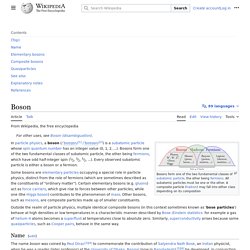
Bosons make up one of the two classes of particles, the other being fermions.[3] The name boson was coined by Paul Dirac[4] to commemorate the contribution of the Indian physicist Satyendra Nath Bose[5][6] in developing, with Einstein, Bose–Einstein statistics—which theorizes the characteristics of elementary particles.[7] Examples of bosons include fundamental particles such as photons, gluons, and W and Z bosons (the four force-carrying gauge bosons of the Standard Model), the recently discovered Higgs boson, and the hypothetical graviton of quantum gravity; composite particles (e.g. mesons and stable nuclei of even mass number such as deuterium (with one proton and one neutron, mass number = 2), helium-4, or lead-208[Note 1]); and some quasiparticles (e.g. Cooper pairs, plasmons, and phonons).[8]:130 Types[edit] Properties[edit]
Field operators. Second Quantization. Dynamics. Unification of fields and particles. Physical meaning of particle indistinguishability. Particle conservation and non-conservation. Axiomatic approaches.